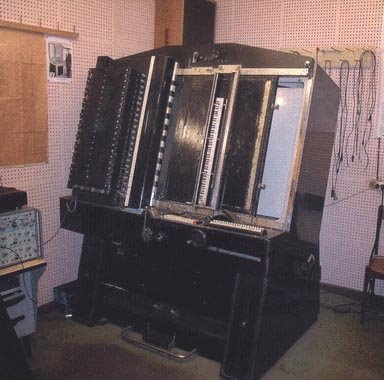Listening to a machine made entirely from windows
An old issue of The Wire introduces us to a synthesizer called the ANS, built in 1950s Moscow by Eugene Murzin and "constructed around a unique and incredibly intricate photoelectronic system."
 [Image: The ANS].
[Image: The ANS].
The ANS functioned through an "array of tiny chisels" that engraved "lines and points on rotating black enamelled glass discs." These engravings would then "regulate the brightness of light rays" that passed "through the discs onto photoelements," like the sun streaming through carefully shaded windows.
The "level of intensity" of this light then produced specific sounds.
Elsewhere (scroll down in this link till you hit the COILANS review), we read about the ANS's unique compositional process: "The composer inscribes his visual 'score' onto a glass plate covered with sticky black mastic, slides it through the machine, which reads the inscribed plate and converts the etchings into sound produced by a system of 800 oscillators."
It's a machine that reads windows.
 [Image: A representative musical score for the ANS – but what if you fed it architectural diagrams?].
[Image: A representative musical score for the ANS – but what if you fed it architectural diagrams?].
The Wire then explains that, in 2002, British band Coil visited the synthesizer in Moscow and recorded nearly 4 hours of music using the machine. Listening to what they produced, we're told, sounds "like travelling through the Oort Cloud or the Kuiper Belt – glitting slivers of distant white light and vast, nebulous spaces populated by inchoate radioactive matter." As you'll notice in these three, 3-minute samples, the effect is certainly weird – but unbelievably mesmerizing: 1, 2, and 3 (all MP3s).
Light, chisels, glass plates, oscillators, enamelled surfaces, engravings on windows – with these elements it is not at all hard to imagine a kind of ANS architecture, rebuilt on the scale of a building. Windowed lobbies and escalators; sunlight; entire lift shafts full of glass discs, inscribed and black-enamelled, emitting music like light. Whole rooms of sound, angelic, the windows slightly trembling.
Moving panes of glass, washed clean at the end of the day, pass slowly behind curtains, casting shadows.
A symphony for glass escalators. Chamber music.
Entire cities, made from nothing but windows, tuning to each other – like the sound of orchestral sunlight.
(Note: The ANS was apparently used to soundtrack Andrei Tarkovsky's films Solaris and Stalker).
 [Image: The ANS].
[Image: The ANS].The ANS functioned through an "array of tiny chisels" that engraved "lines and points on rotating black enamelled glass discs." These engravings would then "regulate the brightness of light rays" that passed "through the discs onto photoelements," like the sun streaming through carefully shaded windows.
The "level of intensity" of this light then produced specific sounds.
Elsewhere (scroll down in this link till you hit the COILANS review), we read about the ANS's unique compositional process: "The composer inscribes his visual 'score' onto a glass plate covered with sticky black mastic, slides it through the machine, which reads the inscribed plate and converts the etchings into sound produced by a system of 800 oscillators."
It's a machine that reads windows.
 [Image: A representative musical score for the ANS – but what if you fed it architectural diagrams?].
[Image: A representative musical score for the ANS – but what if you fed it architectural diagrams?].The Wire then explains that, in 2002, British band Coil visited the synthesizer in Moscow and recorded nearly 4 hours of music using the machine. Listening to what they produced, we're told, sounds "like travelling through the Oort Cloud or the Kuiper Belt – glitting slivers of distant white light and vast, nebulous spaces populated by inchoate radioactive matter." As you'll notice in these three, 3-minute samples, the effect is certainly weird – but unbelievably mesmerizing: 1, 2, and 3 (all MP3s).
Light, chisels, glass plates, oscillators, enamelled surfaces, engravings on windows – with these elements it is not at all hard to imagine a kind of ANS architecture, rebuilt on the scale of a building. Windowed lobbies and escalators; sunlight; entire lift shafts full of glass discs, inscribed and black-enamelled, emitting music like light. Whole rooms of sound, angelic, the windows slightly trembling.
Moving panes of glass, washed clean at the end of the day, pass slowly behind curtains, casting shadows.
A symphony for glass escalators. Chamber music.
Entire cities, made from nothing but windows, tuning to each other – like the sound of orchestral sunlight.
(Note: The ANS was apparently used to soundtrack Andrei Tarkovsky's films Solaris and Stalker).





Comments are moderated.
If it's not spam, it will appear here shortly!
and if you could feed it architectural diagrams it should be on the bias. Beautifully orchestrated buildings at a different speed and rhythm.
I could listen to that for four hours. Seriously.
Possibly a precursor to such computer programs such as MetaSynth or Cthugha.
There are a few cases of image -> sound translation in recorded music at this web page. The imfamous "Aphex Face" is cited here, along with other visual deconstructions.
Small correction -- rather than Cthugha, I meant Coagula.
I loved Solaris and Stalker. Now I know which was one of the reasons. I really like this retro-futuristic music.
Now I am a learning theremin-player. And I sure you: with layers of theremins It is possible to produce simillar tunes. Not sure still? Go to my blog and listen to the mp3 file placed at this post ;).
The ANS was indeed used by Edward Artemyev for his Tarkovsky scores. All of that music (Mirror included) was released on CD by Torso Kino in 1990 (CD 5001). May well be deleted now. Coil also had some music released via Torso at around the same time.
If you like the Coil recordings you'll also like this:
Sliiiiiiiiiiiinky
amazing sound ...
Post a Comment